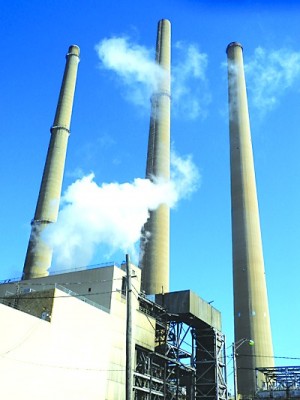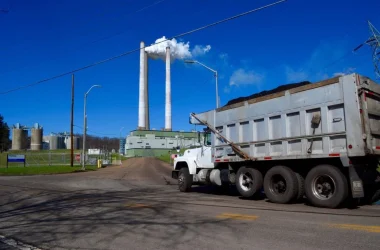
Only the tallest of the three stacks at the American Electric Power Kammer Plant has been in operation since the late 1970s.
MOUNDSVILLE, W.Va. — American Electric Power officials maintain they need to close three West Virginia coal-fired power plants by May 31 to comply with U.S Environmental Protection Agency standards, but state regulators want the firm to justify whether it is the appropriate course of action.
AEP spokeswoman Carmen Prati-Miller said the remaining few employees at Marshall County’s 630-megawatt Kammer Plant are ready to shut off the generator’s lights by the end of the month as part of the company’s plans to meet the requirements of the EPA’s Mercury and Air Toxics Standards. The agency estimates these regulations will help prevent 96 premature deaths in West Virginia and 560 in Ohio.
Along with the Kammer Plant, AEP plans to shutter the Philip Sporn Plant in New Haven, W.Va., and the Kanawha River Plant in Glasgow, W.Va.
“By law, we cannot operate these plants after May 31. A key driver for closing the plants is indeed the new federal emissions standards,” Prati-Miller said, adding the firm is investing $1 billion for transmission system improvements that will help compensate for the loss of wattage.
However, officials with the Public Service Commission of West Virginia want AEP’s Mountain State operating subsidiary, Appalachian Power Co., to explain how closing these plants is the best way to comply with MATS – and to assure them AEP will be able to keep the lights on throughout the state once the plants are closed.
“To determine if closing the plants is indeed the best course of action, the commission needs considerably more information. … Appalachian Power Co. seems to ask the commission to trust it that closing the plants is the best course of action,” PSC attorney John Little wrote, while also requesting commissioners direct AEP not to do anything to the plants that would render them “permanently inoperable.”
Little’s filing on behalf of staff members at the PSC asks commissioners to make a decision on the matter within 30 days. AEP plans to close the plants May 31.
“AEP announced plans to decommission these plants back in 2011, and over the past four years had several cases before the PSC on the subject,” Prati-Miller said.
AEP plans to continue operating the larger and newer Mitchell Plant, located just south of Kammer. Because the Kammer plant sits in the heart of the Marcellus and Utica shale natural gas boom, some wonder why the company could not retrofit the Kammer plant to run on natural gas as a way to meet the new EPA requirements.
“Trying to retrofit a 50-year-old coal-fired power plant to run on natural gas would be very expensive,” Prati-Miller said.
However, the company is converting two units of the the Clinch River Plant in Carbo, Va., to run on natural gas as part of the plan to meet the MATS.
What is now known as the Kammer Plant originally opened to provide electricity to the now closed Ormet Corp. aluminum smelter, located across the Ohio River in Hannibal. Only the tallest of the Kammer stacks, which towers to 900 feet, continues emitting waste. The two slightly shorter towers have not been used since the late 1970s.
AEP Ohio, Wheeling Power, Appalachian Power, Kentucky Power and AEP Generation Sources are all subsidiaries of AEP.
To read more from The Intelligencer/Wheeling News-Register, subscribe here.





